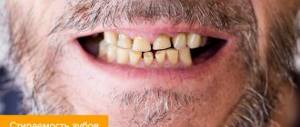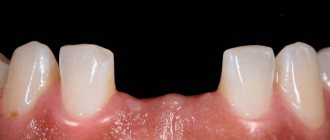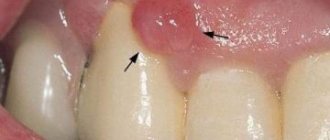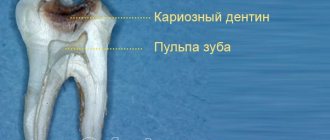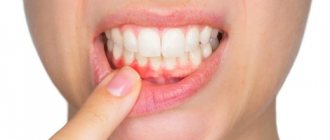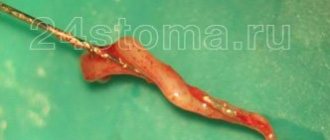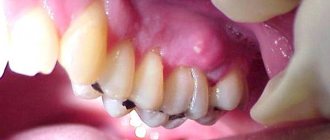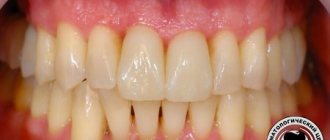Why does tooth wear occur?
What determines the level of tooth wear?
Wearing of teeth throughout life is a natural process that occurs to one degree or another in every person. The level of abrasion of hard dental tissues depends on various factors - the general state of their health, genetic predisposition to various diseases, the quality of food and water quality, sufficient intake of essential minerals, and also work in certain hazardous industries, for example, in the chemical industry, can speed up the process erasing the enamel.
Therapy and restoration work for hypoplasia
For minor lesions, remineralization can be done; in complex situations, more serious intervention will be required. The problem is rarely localized to the molars and premolars. More often, incisors and canines are underdeveloped. Restoring the enamel in this case is impossible, and the only way out is aesthetic restoration. Depending on the degree of tooth decay, a veneer, crown or filling is placed on it, restoring color and shape.
You will learn in detail how you can restore the beauty of your smile using ceramics from the video:
Teeth wear for physiological reasons
When does the process of tooth wear begin?
The process of wearing away tooth enamel begins almost immediately after teeth erupt. This is natural and normal, as it allows the body to adapt to the resulting load. Physiological abrasion is necessary so that the load on the teeth and jaws is distributed evenly and there is no overload of individual areas. Point contacts of teeth turn into planar contacts and the angle of inclination of the teeth changes. This is necessary for a more physiological functioning of the dentofacial apparatus.
It is important to understand that proper physiological tooth wear affects only the outer enamel, without damaging the inner dentin, and occurs only at the points of contact of the teeth.
Wearing of baby teeth in children
Not only molars and permanent teeth in adults wear out, but also baby teeth in children. By about four years of age, the child’s teeth on the incisors, as well as the cusps on the canines and chewing teeth, completely wear out. It is considered normal for the enamel to wear away by the age of six, even down to the dentin.
And in the period until the complete change of baby teeth - up to 13-14 years, the dentinal layer may also be worn out.
Increased abrasion is considered when the tooth cavity becomes visible or the tooth crown is lost.
Methods of treating pathology for initial caries
Inflammation at the initial stage is treated without the use of a drill and anesthesia: this is a painless manipulation that prevents damage to dentin, and the enamel can be considered healthy after treatment. In some cases, only the doctor at the appointment sees white spots on the teeth, so it is better to carry out these procedures immediately after identifying the problem.
Remineralization
Remotherapy is the process of artificially saturating tissues with micro- and macroelements. It is also indicated after prolonged use of splints or braces.
Calcium gluconate is most commonly used by dentists. A swab soaked in the solution is applied to the previously cleaned and disinfected jaw and left for exposure for several minutes. Sometimes the procedure requires repetition.
To ensure long-lasting results:
- brush your teeth with a soft brush and low-abrasive toothpaste;
- exclude too cold and hot, spicy, sour foods for a day or two.
Fluoridation
There is significantly more calcium in bone tissue than fluoride. But the latter plays a decisive role in the process of absorption of calcium compounds. The best results are obtained by alternating saturation procedures.
The doctor performs the operation manually using gel, varnish or tampons containing the desired element. After manipulation, it is not recommended to use medicinal pastes for 2 months.
Electrophoresis, infiltration, ozonation
These are more complex, but nevertheless non-invasive or micro-invasive processes that allow you to restore enamel that is beginning to decompose without pain relief using:
- microcurrents delivering the necessary substances (electrophoresis with calcium or fluorine ions);
- ICON lamps, thanks to them the desired material penetrates the pores of the surface, restoring the enamel layer (infiltration);
- gas that disinfects the entire dentition, ridding it of pathogens, followed by the use of a material that prevents the development of caries (ozonation).
The attending physician will offer the patient several options to choose from, and the final decision on what to do if white spots appear on the teeth is made jointly.
Sealing and silvering of enamel in children
Fissures are depressions and grooves on the chewing surfaces, thanks to which the jaws can grind food efficiently. Despite their usefulness, with insufficient care they become a source of inflammation and proliferation of microbes, especially in children who, due to their age, do not yet fully observe hygiene. Considering the fragility of the tissues of a child’s body, this leads to almost instantaneous development of caries. Sealing (filling) is done with a material similar to a filling material.
After manipulation, dentists recommend a coating - for example, with silver nitrate, a bactericide, which prevents further destruction of the units and keeps the oral cavity sanitized.
Pathological abrasion of teeth
Pathological abrasion
- this is precisely the factor that readers should pay attention to. Because at the first signs accompanying this pathology, it is advisable to consult a dentist as soon as possible.
What signs may accompany pathological tooth wear?
During the examination, the doctor pays attention to the condition of the tooth enamel, how exposed the dentinal layer is - and this affects increased sensitivity
teeth, how much the volume of dental tissue has decreased and how the temporomandibular joint works. Also in the diagnosis, examination of the condition of the skin, the condition of the mucous membranes and tongue, how painfully the masticatory muscles react when pressed, and even the depth of the nasolabial folds can indicate the state of dental health.
Look carefully at yourself in the mirror: pathological wear of teeth is also associated with a violation of the symmetry of the face and the uneven position of the jaws relative to each other.
The doctor also pays attention to the height of the lower part of the face and the sound that is heard when the jaws close
.
A clear, ringing and short sound indicates normal functioning. But a dull and prolonged sound can be a signal of the beginning of the development of pathologies. If you hear a creaking sound, this indicates problems with the temporomandibular joint or possible problems with the nervous system.
Increased tooth sensitivity also indicates abrasion of tooth enamel. The degree of pain depends on the thinness of the enamel, wear of dentin and open dentinal tubules, as well as on how quickly secondary dentin forms.
Causes of pathological tooth abrasion
The habit of holding something in the mouth
or chewing something with the teeth, such as pens, pencils, or seeds.
Consuming acidic foods and drinks
, this includes all lemonades and sodas, as well as vinegar-based marinades.
Bruxism or nighttime teeth grinding, the habit of clenching the jaw tightly
.
Taking certain medications
may lead to thinning of the enamel. In this case, it is important to know about the side effects of the medications you are taking and, for example, take additional vitamins or do dental strengthening procedures.
Stomach and digestion problems
when the contents of the stomach are released back into the mouth. As well as increased stomach acidity and vomiting.
Diseases of the heart and blood vessels
, nervous and endocrine systems also affect dental health.
Malocclusion
or improperly performed orthodontic treatment.
Work in hazardous and heavy industries
– in the chemical, metallurgical industry, cement or granite production, as well as work in mines.
If the enamel of teeth from dentures is worn away
Installation of removable and clasp dentures is fraught with the development of complications, which include abrasion of the enamel of natural teeth. The fact is that the material from which the crown of the prosthetic tooth is made is often harder than the patient’s enamel. During chewing and talking, friction occurs between prosthetic and healthy teeth, which causes thinning of the enamel on the latter.
Artistic restoration and installation of fillings will help restore damaged areas of the tooth. It is best to carry out correction using this method when there is irreversible destruction of the enamel and there are significant defects on the surface of the tooth. Filling is an affordable method that allows you to restore the integrity of a tooth and restore existing cracks or chips. In clinical practice, light-curing composites are most often used, as they best cope with the task.
Why does a tooth hurt after a filling is installed?
Minor soreness may persist for several days or even a couple of weeks, which is explained by overheating of the tissue due to the use of boron. In some situations, for example, with deep caries or when treating front teeth, increased sensitivity can persist even for several months. But in such a situation, you should still consult a doctor for an x-ray to make sure that there is no infected tissue left under the filling and that inflammation has not affected the nerve.
If the pain intensifies, the filling darkens, black spots appear under it - all this indicates that the treatment was carried out poorly and re-inflammation has begun. This is a reason to see a doctor as soon as possible.
How long should you not eat after having a filling installed?
If a filling made of chemical composites is installed, then you should refrain from eating and drinking for 2 hours. This is due to the fact that the material requires a certain time for final shrinkage and hardening.
If a “light” composite filling is installed, you can drink immediately, but you should abstain from food for 1.5-2 hours. But the reason is not in the material (it hardens a few seconds after application), but in anesthesia - with reduced sensitivity of the mucous membranes during eating, you can injure the tongue and mucous membranes of the cheeks on the inside.
During the day after the filling is installed, you should only eat warm foods - excessively hot or cold foods can lead to changes in the shape of the filling. It is necessary to chew food on the opposite side for the first day - this will allow the material to fully “adhere” to the tissues and take the desired shape, without the risk of damage.
Why do teeth crumble in adults?
Causes of tooth decay
Habits that ruin your teeth
What to do to strengthen enamel
Prevention from destruction
Not everyone can boast of healthy and strong teeth. The reason is simple: most of us come to the dentist only when faced with serious problems. One of them is the destruction of enamel: teeth literally begin to crumble into small pieces. Why does this happen and how to strengthen weak enamel?
How to prolong the effect of professional cleaning
It is recommended to visit the dentist for professional teeth cleaning once every six months. To prolong the effect of the procedure, it is recommended to follow the following hygienic care recommendations:
- brush your teeth twice a day with a high-quality brush and properly selected toothpaste;
- use dental floss to clean interdental spaces;
- rinse your mouth after every meal;
- It is advisable to give up or limit the consumption of coffee, black tea, carbonated drinks, alcohol, as well as smoking.
Toothache can exhaust a person, turn him into a pitiful semblance of himself. A huge number of diseases can cause pain: caries, pulpitis, periodontal disease, gingivitis and others. The main cause of these diseases is plaque formed on the teeth, in which pathogenic bacteria constantly multiply. As you know, prevention is easier than cure! You can avoid dental problems with regular home care and professional teeth cleaning. Timely and thorough care of the condition of your teeth is the best prevention of dental diseases, which will provide you with a snow-white smile and fresh breath!
What to do if your gums hurt after filling
The gums in the area where the anesthesia was administered may ache for several days - this is completely normal and does not require any measures. The mucous membrane may also be slightly inflamed if special rings were used during treatment, which are placed on the tooth to form the correct shape of its crown. The gums can also be damaged if the doctor had to install the filling material in close proximity to the mucous membrane or even under it - in such a situation the gums are deliberately pushed back. Therefore, pain is a normal reaction to external intervention.
All of these conditions are variations of the norm. But if the pain intensifies, redness and swelling of the mucous membrane progresses, you need to consult a doctor.
Causes of tooth decay
It happens that the enamel becomes fragile, cannot cope with the load and begins to crumble. Typically this process begins with the formation of small microcracks. Over time, they increase, leading to chips.
Tooth decay is influenced by many factors, both natural and mechanical.
- Poor hygiene. The accumulation of tartar and soft deposits create a favorable environment for the growth of bacteria. Those, in turn, release substances that destroy the enamel.
- Lack of vitamins and microelements that affect the formation of dental tissue, for example, vitamin D, calcium, phosphorus, etc.
- Abuse of sweets, alcohol, sour foods, seeds, smoking, sweet sodas. Simultaneous consumption of foods at different temperatures (ice cream and hot coffee).
- Bad habits: the habit of biting nails, a pen or pencil, opening a bottle with your teeth.
- Bruxism.
- Heredity.
- Diseases of the thyroid gland and endocrine system.
- Age-related changes.
- Pregnancy.
- Chronic diseases: arthritis, diabetes.
- Poor quality water.
Why does the enamel on teeth wear off?
According to scientists, the enamel on teeth wears off for various reasons. Typically, fabric stability is affected by:
- individual characteristics of the structure of teeth;
- genetic predisposition;
- hormonal background;
- mechanical injuries;
- frequent temperature changes when eating hot and cold foods at the same time;
- quality and quantity of saliva;
- calcium and fluorine content in tissues;
- Toothbrush;
- bad habits - smoking, alcohol abuse;
- frequent consumption of sweets, citrus fruits, fruit juices, sodas.
In addition, the enamel on teeth begins to wear off with age. As the body ages, metabolic processes slow down and hormonal stability is disrupted.
Most often, the enamel on the lateral incisors wears off, and less often on the molars.
How is teeth cleaning performed in dentistry?
Teeth cleaning in dentistry involves a sequential set of procedures:
- Removing soft plaque. Using a special electric brush on which professional paste is applied, the doctor cleans the surface of the teeth from contaminants that can still be removed mechanically.
- Cleaning hardened plaque. Using one of the above methods, the dentist removes hard plaque.
- Cleaning interdental spaces. Using special thin metal strips (strips), plaque is removed from the sides of the teeth.
- Polishing. After all the procedures, the surface of the tooth becomes rough. To fix this, use special polishing rollers that will return your teeth to their ideal smoothness.
- Fluoridation. The final stage of professional cleaning is treating the tooth surface with fluoridating varnish, which will strengthen the enamel and prevent the appearance of plaque.

